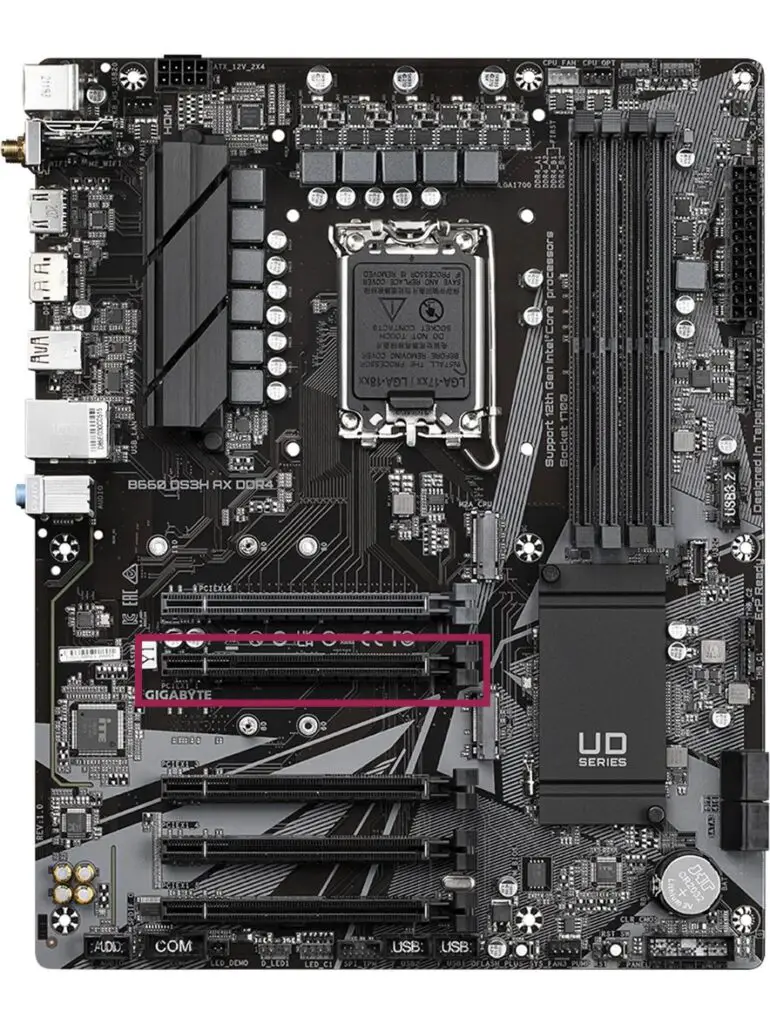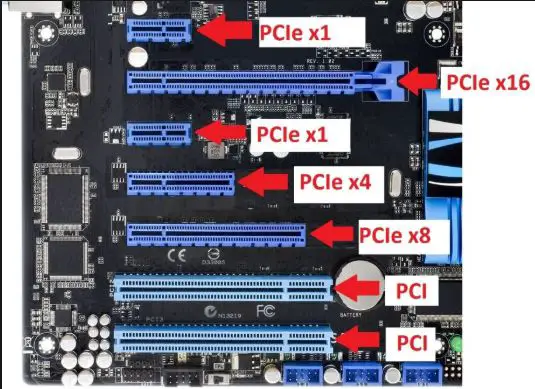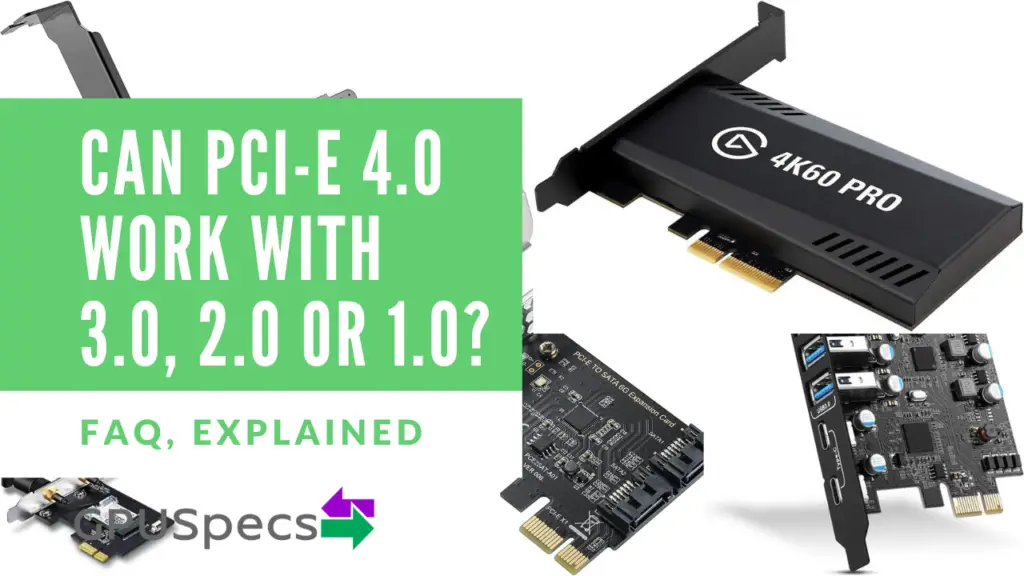Which PCI-e Slot Should I Use?
If you’ve ever built a computer with more than one pci-e slot for your graphics card (or any expansion card for that matter) then you may have wondered if it matters whether you put your graphics card in the top / middle / bottom slot. Usually only high end ATX (full sized) motherboards contain more than one PCI-e x16 slot so on smaller boards you may not have a choice where to put your graphics card.
Table of Contents
The Answer
So let’s just start with the answer to which PCI-e Slot Should I Use? For graphics cards you almost always want to choose the top PCI-e x16 slot. Now let’s find out why.
Different Types of PCI-e Slots
In order to find out why the top slot is the best, we first need to take a look into how PCI-e Slots actually work. PCI-e slots work by having lanes which take the data to and from the connected device to the cpu. A lane is simply a serial connection for data transfer that consists of two wires that typically take the form of traces in motherboards. One wire or trace is for sending data and the other is for receiving data. The amount of lanes determines how much data can be sent at a given time. PCI-e Slots contain most commonly 1, 4, 8, 16 and 32 lanes giving us pci-e x1, x4, x8, x16 and x32.
PCI-e x32 slots are very rare so whilst we included them here, they’re really not something you’re probably going to be using or worrying about.
| Type of PCI-e | Bandwidth | Number of Pins | Length |
|---|---|---|---|
| PCI-e x1 | As much as one lane supports depending on if it's PCI-e 1.0,2.0,3.0,4.0,5.0 | 18 | 25 mm |
| PCI-e x4 | Four times that of PCI-e x1 | 21 | 39 mm |
| PCI-e x8 | Two times that of PCI-e x4 | 49 | 56 mm |
| PCI-e x16 | Two times that of PCI-e x8 | 82 | 89 mm |
| PCI-e x32 | Two times that of PCI-e x16 | - | - |
Different PCI-e Versions
So as with most tech interfaces and devices, PCI-e has multiple versions. Think of the likes of USB 2.0, 3.0, 3.1, 3.2 etc. The current PCI-e versions are PCI-e 1.0, 2.0, 3.0, 4.0 and 5.0 with PCI-e 6.0 coming in the future. Each PCI-e version has about two times the bandwidth when compared to the previous version. There are also different type of PCI-e Slot which you can read about here.
| Generation | Release Year | Gigatransfer | Frequency | Bandwidth per Lane (one direction) |
|---|---|---|---|---|
| PCI-e 1.0 | 2003 | 2.5 GT/s | 2.5 GHz | 250 MB/s |
| PCI-e 2.0 | 2007 | 5 GT/s | 5 GHz | 500 MB/s |
| PCI-e 3.0 | 2010 | 8 GT/s | 8 GHz | 1 GB/s |
| PCI-e 4.0 | 2017 | 16 GT/s | 16 GHz | 2 GB/s |
| PCI-e 5.0 | 2019 | 32 GT/s | 32 GHz | 4 GB/s |
| PCI-e 6.0 | 2021 | 64 GT/s | 32 GHz | 8 GB/s |
Now that we know the bandwidth per lane for each PCI-e generation, we can calculate the bandwidth when we have multiple lanes. Think of the bandwidth per lane above to be for PCI-e x1 since it’s only using one lane.
| Generation | x1 | x4 | x8 | x16 | x32 |
|---|---|---|---|---|---|
| PCI-e 1.0 | 250 MB/s | 1 GB/s | 2 GB/s | 4 GB/s | 8 GB/s |
| PCI-e 2.0 | 500 MB/s | 2 GB/s | 4 GB/s | 8 GB/s | 16 GB/s |
| PCI-e 3.0 | 1 GB/s | 4 GB/s | 8 GB/s | 16 GB/s | 32 GB/s |
| PCI-e 4.0 | 2 GB/s | 8 GB/s | 16 GB/s | 32 GB/s | 64 GB/s |
| PCI-e 5.0 | 4 GB/s | 16 GB/s | 32 GB/s | 64 GB/s | 128 GB/s |
| PCI-e 6.0 | 8 GB/s | 32 GB/s | 64 GB/s | 128 GB/s | 256 GB/s |
Why choosing the top slot matters
So you may be wondering by now why you should pretty much always use the top slot for your graphics card and it’s to do with the fact that not all PCI-e slots are created equally.
The first most obvious part is that manufacturers usually make the top slot the fastest speed in terms of PCI-e generation. While this varies from motherboard to motherboard, there are a motherboards out there which support PCI-e 4.0 on the top slot and only PCI-e 3.0 on the other slots. This is just an example but there are many variations and similar things motherboard manufacturers do. The best way to know if the slots on your motherboard have different PCI-e versions is to check the manual. Most higher end motherboards will have the same high speeds throughout.
Now the next slightly less obvious but commonly overlooked problem is that slots aren’t always what they look like they are. Here, have a look at this slot below and say whether it’s an x1, x4, x8 or x16 slot.

PCI-e x16? WRONG! This is actually a PCI-e x1 slot. But I know what you’re thinking it is the same size and looks exactly the same as a PCI-e x16 slot. In fact the slot above it is an x16 slot which is almost identical. The reason is that motherboard manufacturers make some of their slots longer than the actually pins go. So it may be a PCI-e x16 physically, electronically it’s only an x1 slot.
It actually even says on the motherboard that it’s an x1 slot next to the label PCIEX1_1 and if you look even closer you can see the pins don’t even go all the way to the end of the slot.
You can check gigabyte’s manuals online to see the types of PCI-e slots they have on their motherboards and view which are actually PCI-e x16 and which are not.
So what does this all mean?
So if you accidentally use a PCI-e x1 slot instead of an x16 then your bandwidth will be significantly decreased. Therefore you will experience a big drop in performance as your graphics card is going to be heavily bottlenecked by this. The same applies for using a lower PCI-e generation since the bandwidth is lower.
Does it actually matter which PCI-e slot I use?
If you’re using a really high end board and you’ve checked the slots properly, then the chances are you won’t actually see any decrease in performance.
Depending on how much lower your bandwidth is will change how much of a performance decrease you will get. This is also dependent on your graphics card. Higher end graphics cards tend to suffer more if there is a decreased bandwidth. So if you’re using a really high end card you will definitely notice a difference by using the correct top slot. However, if you’re using a mid range graphics card in the wrong slot, then you may not even notice a difference.
There are too many motherboards and graphics cards to be able to give a definite answer on how much performance difference there is but to avoid any performance drops you should use the top slot.
My card doesn't fit in the top PCI-e x16 slot can I use a different one?
Yes, but make sure that the slot is x16 and the highest version of PCI-e that your motherboard supports or you will face decreased performance. The decrease may however be negligible if you’re using a mid range graphics card as these don’t require as much bandwidth.
Consider using a PCI-e Riser or vertical GPU mount to fit your graphics card if it doesn’t fit.

Using two graphics cards
When using two graphics cards, you may not get the performance increase you were expecting. Sometimes the lanes are split between two graphics cards so you may only get 8 lanes each on two graphics cards. This is like running two graphics cards both on a PCI-e x8 slot. It’s almost always better to get a single more power graphics card rather than two lower powered graphics cards.
Which slot do I use for a capture card or any other expansion card
Use any that are available but you should have your graphics card in the top slot. You might also want to check that the slot is the correct size electronically so you don’t have any performance decreases caused by low bandwidth. Some slots may be x16 in size but on have enough pins to be a x4 slot so the bandwidth is lower.
Conclusion
So now you know that you should almost always use the top slot of your motherboard for your graphics card and any other expansion cards can follow after. An easy way to check if the slot is the actual size you think it is, is to check the label given on the motherboard. If you’re still unsure you can consult the motherboards manual.





